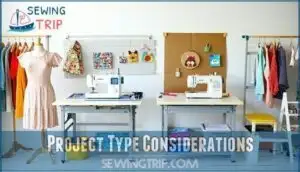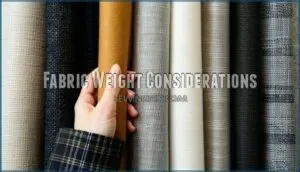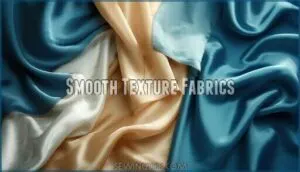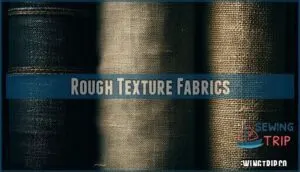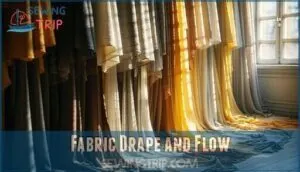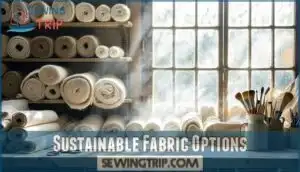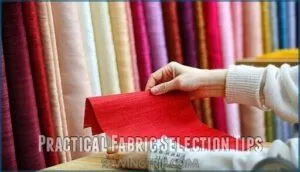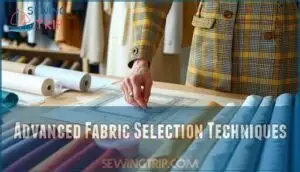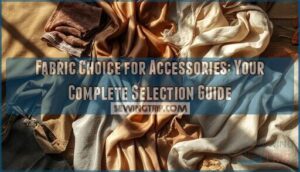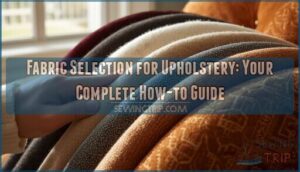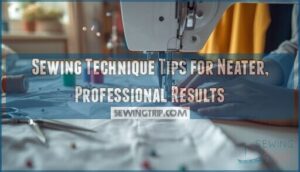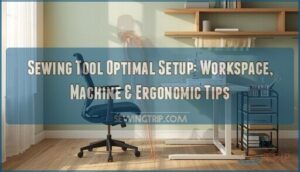This site is supported by our readers. We may earn a commission, at no cost to you, if you purchase through links.
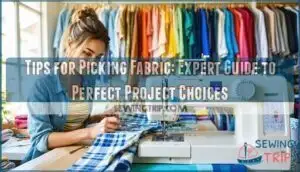
Cotton breathes well for everyday wear, while synthetics work great for activewear.
Check the weight—lightweight fabrics like chiffon flow beautifully but won’t hold structure like denim or canvas.
Feel the texture and watch how it drapes in your hands.
Consider your skill level too; beginners should avoid slippery silks that slide around like escape artists.
Don’t forget practical stuff like care instructions and whether it’ll shrink.
Your fabric choice can make or break your project, so take time to match the material to your vision.
The right fabric transforms good sewing into something spectacular, making everyday wear and activewear look great, and it is crucial for beginners.
Table Of Contents
Key Takeaways
- Match fabric to your project’s purpose first – You’ll get better results when you choose cotton for breathable everyday wear and synthetics for activewear that needs moisture-wicking properties.
- Consider fabric weight alongside your skill level – You should start with medium-weight fabrics like cotton if you’re a beginner, and avoid slippery materials like silk that’ll slide around and frustrate you.
- Test the fabric’s drape and texture before buying – You can predict how your finished project will look by holding fabric samples up to see how they flow and feel against your skin.
- Factor in care requirements and durability needs – You’ll save yourself headaches by checking if the fabric shrinks, needs special washing, and whether it’ll hold up to your project’s intended use.
Fabric Selection Basics
You’ll master fabric selection by understanding the three main fiber categories and their unique properties.
Natural fibers like cotton and silk offer breathability and comfort, while synthetic options like polyester provide durability and stretch recovery.
Natural Fiber Characteristics
When selecting natural fabrics, you’ll discover each fiber brings unique qualities to your projects.
Cotton breathability makes it perfect for everyday comfort, while linen cooling properties excel in warm weather.
Choose cotton for breathability, linen for cooling – let fabric properties guide your comfort decisions.
Understanding these fabric properties helps you match natural fibers to your specific needs.
- Cotton: Absorbs moisture naturally and feels soft against skin
- Linen: Keeps you cool with its loose weave structure
- Silk: Drapes beautifully with elegant flow and natural sheen
Synthetic Fiber Properties
Synthetic fibers pack a powerful punch in the fabric world.
Polyester properties include excellent wrinkle resistance and quick-drying abilities, while nylon durability makes it perfect for activewear and outdoor gear.
Acrylic softness mimics wool’s warmth without the itch factor.
Spandex stretch transforms any fabric into a flexible powerhouse, and microfiber uses range from athletic wear to cleaning cloths.
These synthetic fibers offer superior breathability and stretch compared to many natural options.
However, remember that synthetics often rely on complex chemical processing for their unique properties, which can be a significant consideration for some users, highlighting the importance of quick-drying abilities and wrinkle resistance.
Blended Fabric Advantages
Blended fabrics offer the best of both worlds by combining natural and synthetic fibers.
Smart fabric choices combine natural comfort with synthetic durability for superior results.
You’ll get durability boost from synthetics plus breathability from natural materials. This smart fabric selection delivers cost savings and enhanced comfort while maintaining wrinkle resistance for versatile applications.
- Durability Boost – Synthetic fibers add strength to natural materials, creating fabrics that last longer than single-fiber options
- Cost Savings – Blends often cost less than pure natural fibers while delivering superior fabric properties and performance
- Enhanced Comfort – Natural fibers provide breathability while synthetics add stretch and moisture-wicking capabilities for all-day wear
- Wrinkle Resistance – Synthetic components reduce creasing, making blended fabrics perfect for travel clothes and busy lifestyles
Choosing Right Fabric
You’ll make better fabric choices when you consider your specific project needs and the person who’ll wear the finished piece.
Smart fabric selection means matching the material’s properties to your project type, the occasion it’s for, and your comfort and skill level as a sewer.
Project Type Considerations
Your project type dictates fabric selection more than you might think.
Different projects demand specific fabric properties for ideal results.
| Project Type | Fabric Requirements | Best Fabric Options |
|---|---|---|
| Garment Construction | Drape, stretch, comfort | Cotton, silk, jersey knits |
| Home Decor | Durability, stain resistance | Canvas, upholstery blends |
| Craft Projects | Easy handling, fraying control | Felt, cotton poplin |
Whether you’re tackling clothing construction or creating artistic textiles, matching fabric suitability to your project prevents frustration.
Industrial applications need tough materials while delicate craft projects require gentler handling.
Smart fabric selection saves time and delivers professional results.
Occasion and Weather Factors
Weather and occasion shape your fabric choices more than you might think.
Formal events call for structured fabrics like wool crepe or silk that maintain their shape under indoor climate control.
Summer weddings need breathable cotton blends with fabric ventilation.
Outdoor activities require weather-resistant synthetics that handle moisture and wind.
Consider seasonal fabrics that match your climate considerations. For athletic wear, consider polyester and nylon for their moisture-wicking properties.
Wearer Comfort and Skill Level
Consider your wearer’s comfort needs and your own sewing skills when selecting fabric.
Fabric breathability matters for skin sensitivity – cotton works well for beginners while silk requires experience.
Match fabric complexity to your skill level.
Simple weaves suit novice sewers better than tricky materials like stretchy knits.
Project enjoyment increases when you choose appropriate fabrics for your abilities and the wearer’s comfort requirements.
Fabric Weight Considerations
You’ll discover that fabric weight directly impacts your project’s success and wearability. Understanding GSM (grams per square meter) helps you match the right fabric density to your specific sewing goals.
Lightweight Fabric Uses
Lightweight fabrics under 150 GSM create flowing, ethereal garments perfect for warm weather projects.
These breathable materials offer comfort and elegance for various applications.
Top lightweight fabric uses:
- Summer Dresses – Chiffon and voile provide graceful drape
- Blouse Materials – Cotton voile offers professional comfort
- Scarf Creation – Silk georgette delivers luxurious movement
Choose lightweight fabrics for lingerie design and breezy wear where breathability matters most.
Medium Weight Fabric Applications
Medium weight fabrics (150-350 GSM) are your workhorses for everyday garments.
Cotton chambray and linen blends offer versatile drape that works beautifully for both casual shirts and custom-made trousers.
These shirt materials provide the perfect balance between structure and comfort.
When selecting fabric weight for clothing projects, medium weight fabrics deliver reliable performance without being too stiff or flimsy.
For easy reference, you can consult fabric weight charts to aid in your selection.
Heavyweight Fabric Projects
Heavyweight fabrics over 270 GSM pack serious durability for demanding projects.
You’ll find denim perfect for jeans and jackets, while canvas creates sturdy bags and outdoor gear.
These industrial textiles shine in upholstery applications where fabric durability matters most.
Consider heavyweight options when your project needs to withstand daily wear and tear, and demanding projects require extra strength.
Fabric Texture and Drape
When you run your fingers across fabric, you’re feeling the story it’ll tell in your finished project.
The texture and drape work together like dance partners – smooth fabrics like silk charmeuse flow like water, while rough textures like burlap add character and structure to your creation.
Smooth Texture Fabrics
Smooth fabrics feel like silk against your fingertips and create elegant drape in garments.
Silk charmeuse and satin weaves offer luxurious fabric aesthetics with their glossy surfaces.
Microfiber benefits include durability and easy care. Crepe finishes provide subtle texture while maintaining smoothness.
Blended smoothness combines natural and synthetic fibers for ideal fabric properties and a soft feel.
Rough Texture Fabrics
Textured fabrics like canvas and denim pack serious punch for your toughest projects.
These rough-surface champions boast superior fabric durability through weave tightness and abrasion resistance. Canvas handles upholstery applications while denim conquers everyday wear.
Industrial uses demand these workhorses because texture analysis reveals their exceptional fabric properties. When fabric selection requires strength over silk-smooth aesthetics, rough textures deliver reliability.
They are chosen for their ability to withstand heavy use, making them ideal for applications where durability is key.
Fabric Drape and Flow
Understanding fabric drape helps you predict how your finished project will move and hang.
You’ll want to test the drape coefficient by holding fabric samples against your body or over a table edge.
The fabric hand—how it feels when you touch it—reveals fluidity factors that affect the final garment’s flow.
Different drape styles work better for specific projects, so conduct simple hang testing before committing to your fabric choice.
Sustainable Fabric Options
You’re making a smart choice when you pick sustainable fabrics for your sewing projects.
These eco-friendly options help protect the planet while still giving you the quality and performance you need for beautiful, long-lasting creations that are also sustainable.
Eco-Friendly Fiber Sources
You’ll discover that organic cotton tops the list of sustainable fabrics.
This powerhouse fiber uses 91% less water than conventional cotton and skips toxic pesticides entirely.
Tencel Lyocell offers another winning choice with its closed-loop production process.
Plant-based fibers like hemp and bamboo grow quickly without chemicals.
These eco-friendly fabrics prove you don’t need to sacrifice quality for sustainability.
Many options like linen are fully biodegradable fabrics, which is a key aspect of choosing eco-friendly materials.
Recycled and Repurposed Fabrics
Treasure hunting in your own closet can yield amazing fabric finds! Recycled fabrics breathe new life into old garments while repurposed materials transform discarded textiles into fresh projects.
These sustainable choices support Textile Waste Reduction and showcase your creativity. Sustainable fabrics also offer improved resource efficiency.
- Upcycling Fabric Scraps from previous projects into patchwork designs or appliqué details
- Closed-Loop Systems where old clothing becomes new fabric through innovative recycling tech
- Consumer Reuse Incentives like fabric swaps and donation programs that keep textiles circulating
Certifications and Labels
Quality certifications act like a fabric’s resume – they tell you what you’re really buying.
Look for GOTS certification on organic fabrics and OEKO-TEX standard labels that guarantee safety testing.
These green certifications and environmental badges help you spot truly sustainable fabrics among the pretenders.
Fair Trade and Organic labels add social responsibility to your project.
The GOTS label assures shoppers of responsible manufacturing.
Practical Fabric Selection Tips
Now you’re ready to put theory into practice with hands-on fabric selection skills. These practical tips will help you identify quality materials and handle them properly from start to finish.
Identifying Quality Fabrics
Beyond the fabric store’s endless rows, you’ll spot quality fabrics by examining key indicators.
Check fiber content labels for natural or high-grade synthetic materials. Test weave tightness by holding fabric to light—loose weaves show more gaps.
Quality fabrics resist common defects:
- Uneven dye patterns signal poor processing
- Snags or pulled threads indicate weak construction
- Fabric flaws like holes or inconsistent texture
Look for ethical certifications and higher double rub counts for durability.
Pre-Treatment and Care Instructions
Smart fabric care starts before you cut.
Always check fabric care instructions and consider prewashing to prevent shrinking.
Test washing techniques on scraps first.
Your drying methods matter—heat can damage delicate fibers.
Learn proper ironing guidelines for each fabric type.
Master stain removal basics and plan storage solutions.
To improve results, consider using fabric preparation products to enhance your fabric care.
These washing instructions save projects from disaster.
Working With Specialty Fabrics
Specialty fabrics like lace, leather, and faux fur require specific techniques for success.
Use non-stick presser feet for leather crafting to prevent sticking.
Lace application benefits from tissue paper stabilizers underneath.
Walking feet control dense materials effectively.
Remove beads from seam allowances before sewing.
Consider essential lace sewing techniques for best results.
These performance fabrics serve unique purposes, so match your aesthetic selection with proper tools for professional results to achieve the desired aesthetic selection.
Advanced Fabric Selection Techniques
Once you’ve mastered the basics of fabric selection, you’ll need advanced techniques to tackle complex projects like fitted garments and intricate patterns.
Understanding stretch recovery, grainline precision, and specialized tools will transform your sewing from good to professional-quality.
Stretch and Recovery Factors
Understanding fabric elasticity helps you choose materials that maintain their shape through countless wears.
Your project’s success depends on matching stretch percentage to garment demands.
Here’s what impacts textile elasticity:
- Spandex content – Higher percentages (3-5%) deliver superior elastic recovery and fiber memory
- Knit construction – Looped yarns provide more stretch than woven fabrics
- Blends impact – Polyester-elastane combinations offer balanced comfort and recovery rates
- Stretch direction – 4-way stretch returns to original dimensions better than 2-way
- Quality testing – Check if fabric bounces back after gentle stretching
Remember: fabrics without elastane show minimal recovery and risk permanent sagging.
Grainline Alignment and Pattern Making
Once you’ve considered stretch and recovery, grainline alignment becomes your roadmap to professional results.
Understanding fabric grain direction prevents wonky hemlines and twisted seams that’ll make you look like a sewing novice.
| Grainline Type | Characteristics | Best For | Cutting Tips | Common Mistakes |
|---|---|---|---|---|
| Straight Grain | Parallel to selvage, minimal stretch | Structural pieces, button bands | Use long ruler for accuracy | Ignoring fabric fold alignment |
| Cross Grain | Perpendicular to selvage, slight stretch | Fitted garments, waistbands | Mark with chalk before cutting | Confusing with straight grain |
| Bias Grain | 45-degree angle, maximum stretch | Curved seams, draping | Cut single layer only | Stretching while handling |
| True Bias | Exact 45-degree diagonal | Binding, cowl necks | Pre-stretch before cutting | Mixing up bias directions |
| Off-Grain | Crooked fabric alignment | Avoid for fitted garments | Straighten before layout | Assuming it’ll block out |
Proper grainline orientation affects how your finished project hangs and moves.
Pattern pieces include grainline arrows that must align with your fabric’s straight grain.
Layout techniques matter—you can’t just wing it and hope for the best.
Using Specialized Sewing Feet and Tools
Your fabric choice determines which specialized tools you’ll need for success.
Walking feet work wonders with slippery fabrics like silk and satin.
A Blind Hem Foot creates invisible hems on medium-weight fabrics.
Teflon feet benefits include smooth gliding over sticky materials.
Gathering Foot Techniques help you create ruffles effortlessly.
Edge Joining Foot connects seams perfectly.
Bias Tape Foot streamlines binding applications.
Quality cutting tools and fabric marking tools complete your arsenal.
Many sewers find walking foot attachments indispensable for certain projects, and specialized tools are essential for success with various fabrics, including the use of a walking foot.
Frequently Asked Questions (FAQs)
How do I choose the best fabric for my sewing project?
Perfect project picks require matching fabric weight, drape, and durability to your design’s purpose. Consider breathability for summer wear, structure for coats, and performance features for activewear projects.
How do you choose a fabric?
Consider your project’s purpose first.
Check fabric weight, drape, and durability against your needs.
Feel the texture, read care labels, and match the material’s properties to your garment’s function and style.
How do I choose a fabric for my sewing machine?
Did you know 86% of people prefer cotton for comfort?
Check your sewing machine’s manual for compatible weights.
Start with medium-weight cotton, avoid slippery or stretchy fabrics, and remember—your machine’s like Goldilocks: picky, but worth it!
How do I enhance my fabric-buying experience?
You’ll transform your fabric shopping by feeling textures firsthand, testing drape and weight, checking care labels thoroughly, and comparing prices across multiple suppliers for quality.
How do I choose the best fabric for a dress?
Choose fabric based on your dress’s purpose and style.
Consider weight for drape, fiber content for comfort, and care requirements.
Cotton works for casual wear, silk for elegance, and blends offer versatility.
How do you match fabric to a sewing project?
Match your fabric’s weight and drape to your project’s function.
Lightweight fabrics work for flowy garments, while heavyweight options suit structured pieces.
Consider durability needs, care requirements, and how the fabric’s texture complements your design vision.
How do I choose the right fabric?
The secret to perfect fabric selection isn’t just matching colors—it’s understanding your project’s soul.
Consider weight, drape, and durability first.
Match fabric properties to your garment’s purpose while checking care requirements.
What are the four things to consider when choosing fabric?
When selecting fabric, you’ll want to take into account these four key factors: the project’s intended use and environment, the fabric’s weight and drape characteristics, durability requirements, and care instructions.
How to pick fabric for a quilt for beginners?
Picking your first quilt fabric feels overwhelming as a mountain of choices.
Start with 100% cotton for easy handling. Choose coordinating colors you love.
Pick medium-weight fabrics around 150-200 GSM for structure and durability.
How do fabric prices compare across different retailers?
You’ll find fabric prices vary dramatically between retailers.
Online retailers have lower overhead costs and can offer lower prices, while big box stores offer fabrics under $5 per yard versus specialty shops.
Conclusion
Mastering these tips for picking fabric will transform your sewing adventures from frustrating fumbles into confident creations.
You’ll save time, money, and countless headaches by matching the right material to your project’s needs.
Remember that fabric choice isn’t just about looks—it’s about function, durability, and how the finished piece will feel and perform.
With practice, you’ll develop an intuitive sense for what works best for each project you tackle.
- https://sino-silk.com/fabric-weight-guide/
- https://missmaudesewing.co.nz/blogs/miss-maude-musings-1/what-is-fabric-weight
- https://corefabricstore.com/blogs/tips-and-resources/fabric-weights-blog
- https://successfulfashiondesigner.com/fabric-weight-guide/
- https://www.textileglossary.com/terms/fiber-content.html

